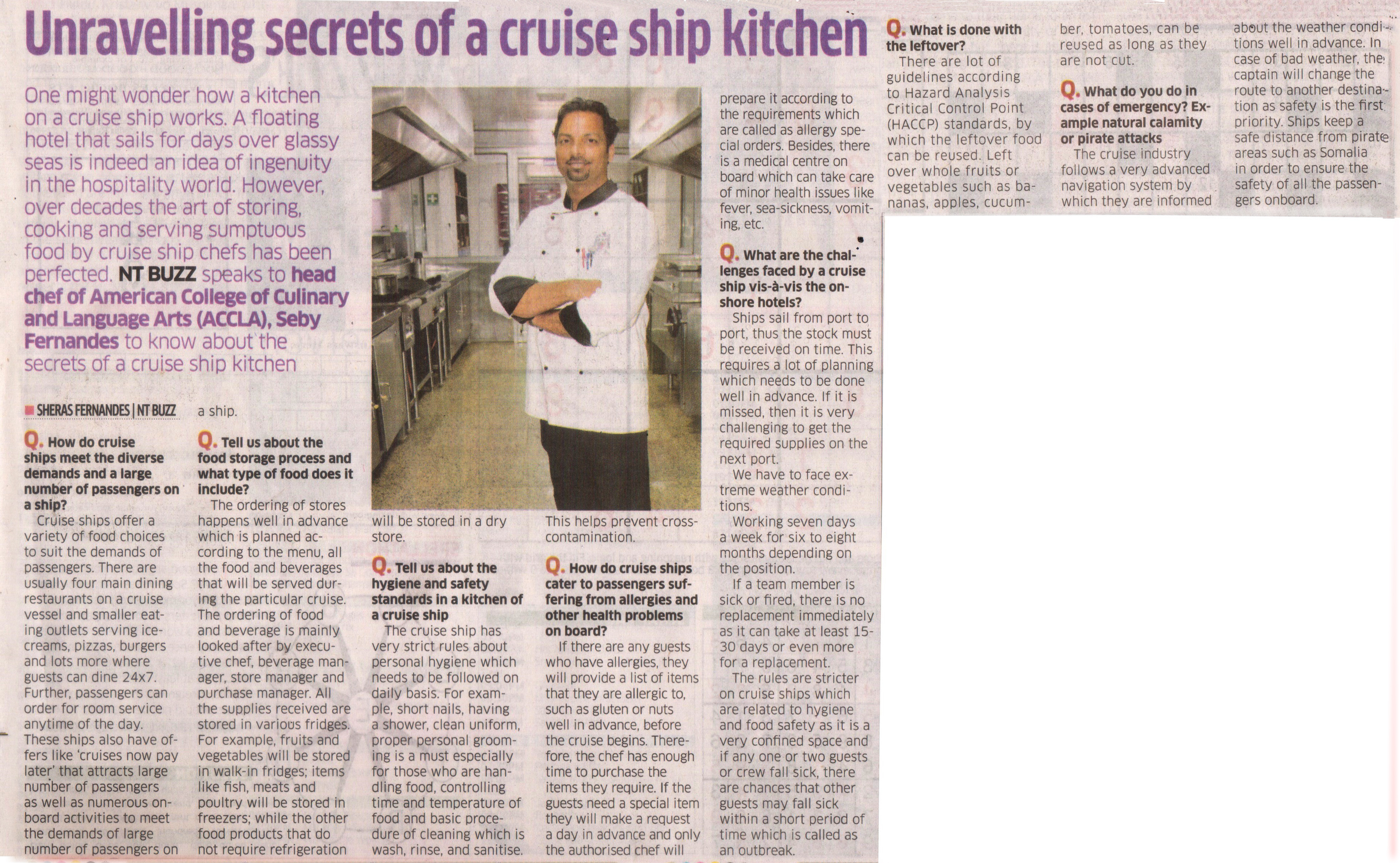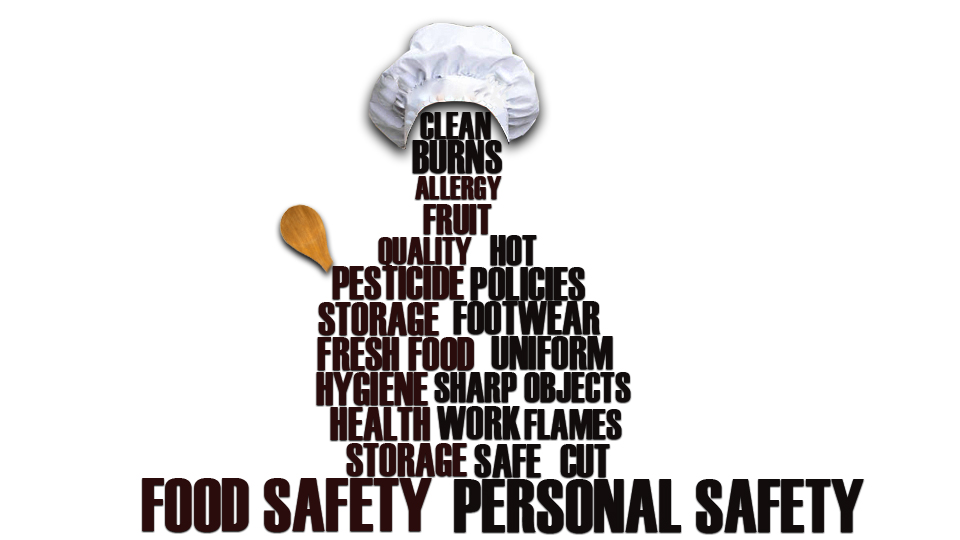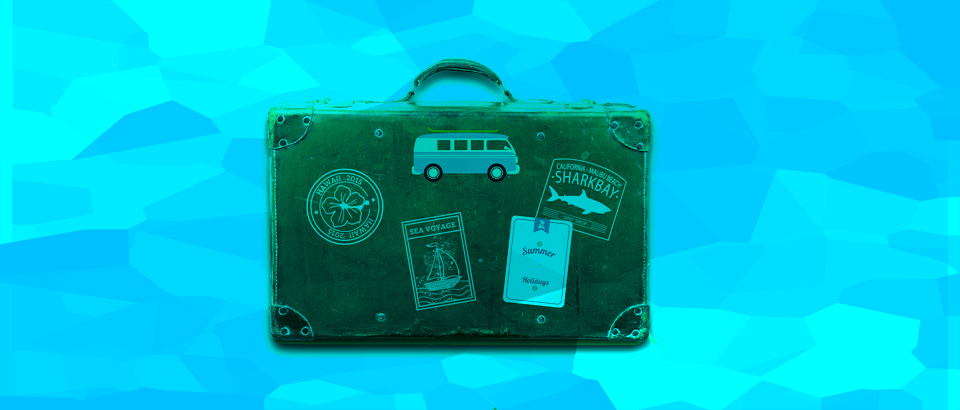Coverage received on Navhind Times: The Article can be read here…
Monthly Archives: June 2017
Safety in Cruise Ship Chef Jobs
While most people view the physical safety of passengers as a priority, what happens deep in the belly of the cruise ship can also gravely affect them. Cruise ship chef jobs lay as much focus on cooking as they do on safety in the galley to ensure the smooth functioning of the food service operation.
The two main kinds of safety in the galley are food safety and personal safety
Food safety
With thousands of people within such close proximity to each other, it is easy for germs to spread, even bacteria from food. Food-related illnesses such as norovirus or E.coli have spread to epidemic proportions on ships as cross-contamination occurs easily from one passenger to the next. So it is ideal to reduce risks at the source itself.
All food on board ships are required to meet certain safety standards. Your culinary institute will teach you the best practices to keep edible items fresh and germ-free. Temperatures in the galley and more importantly storage areas are vital, as ships go into port once every few days. Food must be stored at temperatures that kill, or at least discourage, the growth of germs that can cause illnesses.
Cruise ship chefs learn how to prevent cross-contamination through good cooking and hygiene practices. Consistently keeping the work space clean ensures food that’s ready to be served is safe from germs that may be on raw produce.
Safety measures also need to be taken when handling food during service, and also when cleaning and sanitising dishes, equipment, storage containers and food preparation areas.
Personal safety
Staying safe while at work allows for better efficiency. A cruise ship chef’s job requires full attention when using knives and choppers so there is less chance of serious injury. It’s also important to ensure that your hands are dry when using electrical equipment such as blenders while dangerous parts such as blades are secure before switching the device on.
On ships, chefs have a few more safety measures compared to their land-based counterparts. Pots should never be filled to the brim so hot liquid does not splash around. Chefs are also advised to never heat grease in an oven in case it overheats and catches fire.
It’s important for chefs to wear their uniform so they are protected from accidentally spilled hot liquids or burns. Proper footwear is also important to keep feet and toes safe from hot gravies or heavy vessels. Any spills are cleaned up immediately to avoid people slipping and falling.
Cruise ships add an additional layer of safety by avoiding any open flames in the galley. All stoves, ovens and even grills are electric as fire is one of the biggest hazards on board. In addition, fire extinguishers are within easy reach in all galleys and food preparation areas, and all staff are trained how to use them.
There are many measures that cruise companies insist on regarding safety on board, particularly in the galleys. Staffs receive regular training to keep them up-to-date with new regulations and also to refresh their memory when joining on new contracts. This ensures fewer injuries and better work efficiency.
Art and Food Combine for Cruise Ship Chefs
On board, one doesn’t need to go very far to see beauty. Everything is made to be pleasing to the eyes. So when two of a guest’s favourite things – beauty and food – combine, you know you have a winner.
Cruise ship chef jobs include more than just making delicious food to international standard. It means creating pieces of culinary art, both in the sense of beauty and of use of ingredients.
On board, cruise ship chefs work against restrictions of using ingredients within a designated time frame. Knowing how to use ingredients that may not look perfect or taste a little overdone is also an art.
Produce with short shelf lives such as fruit and vegetables needs to be used quickly. But certain items can be turned into delicious dishes such as jams, cobblers, pancakes, fritters, cakes and smoothies even when overripe. Bread that’s been overbaked turns into decorative pieces for the buffet, panko or breadcrumbs.
Culinary art has pervaded most spaces on a cruise line. Even cupcakes at the corner patisserie are dressed daintily with frosting, edible dust or perhaps a sprig of fresh herb. Plating is an important technique taught in many culinary schools today. Without a tastefully decorated plate, the power of first impression is lost.
Thanks to social media and literature both online and otherwise, cruise companies are enticing guests with images, and food plays an important part here. Cruise ship chef jobs demand an artistic eye along with discerning taste to climb the hierarchy ladder.
The first step to creating an exquisitely designed dish is to imagine what it will look like. Top chefs have even resorted to using paper cut outs of the elements of the dish to decide what it will finally look like. It’s like a painter imagining the final product, making rough sketches and then working on the masterpiece.
When assembling, it’s always safe to start at the centre of the plate and then move outward. Most dishes revolve around a main player, and based on its shape and size, you can then create beautiful patterns around it with the sides and garnishes.
Sauces, gravies and pan jus should either be spooned on last or served in a gravy boat alongside. To keep these runny ingredients from ruining your piece of art, drain the juices before placing the centrepiece of your creation on the plate. Then you can ladle them over as desired later.
Just like a painting, the visual presentation of food should be harmonious, so all the colours on your plate should blend seamlessly with the colour of the plate. Most chefs choose white plates as these provide the perfect background, but many choose black to create a sharp contrast with brightly coloured elements or other shades such as powder blue, or perhaps even serve on a wooden board. Colours are important as they change the diner’s perception of their food – yellow eggs on a yellow plate will look paler and perhaps, to the guest, less fresh.
The most important part of culinary art, just like other art, is that the dish must speak to the guest. So your overall presentation should sum up what you’re hoping for the guest to perceive from your food. Both, the edible elements and visual elements, should blend together fluidly. For example, using drops of emulsified oyster, along with edible seaweed sand and clam-flavoured sea foam as your garnish can tie in your idea of the sea, both visually and gastronomically.
To be a true culinary artist, you must think like one and approach every dish as a painter would approach a blank canvas.
Cruise Ship Jobs: Pros and Cons
Every job has aspects of it that you absolutely love and others that don’t appeal to you all that much. It’s the same case with cruise ship jobs, but compared to land-based employment, working at sea is quite different. Let’s look at a few advantages and disadvantages of cruise ship jobs.
PROS
Savings
This is the single biggest advantage of working a cruise ship job, particularly for staff originating from developing countries. Cruise crew are mostly paid in dollars, and with excellent exchange rates, earnings are much higher compared to land-based jobs of the same position.
Additionally, almost all essentials are paid for on board, so you spend next to nothing getting by. You get free accommodation, food and medical insurance, low-cost laundry, communication, medicines, and even entertainment. Everything you earn can go straight to savings.
For someone starting out and looking to put together a chunk of money for something big, like a house, expensive medical treatment for a family member or even an advanced college degree, a cruise ship job is ideal.
Travel
Being moving hotels, cruise ships naturally call in at the most picturesque ports in the world. On one’s own steam, it would be difficult even imagining a holiday at places like St Maarten, the fjords of Norway or even the Arctic circle. But as part of the crew, you’ll have no choice but to travel to some of the most coveted holiday destinations in the world.
Many cruise ships have a dedicated crew manager who ensures that those off duty get a chance to tour the ports or call, often at a lesser fee than the tours for guests. Cruise ship jobs ensure your passport pages are filled with stamps that make your friends jealous.
Friendship
People from around the world sign up for cruise ship jobs. So it’s only natural that you will meet and work with people of different nationalities. Working on a cruise ship offers opportunity to learn cultures and even languages of new friends from everywhere, from Scandinavia to Asia, Africa to Australasia, the Americas to the Middle East. It serves as an excellent way to widen perspectives and enrich lives.
CONS
Long hours
The service and hospitality industry is notorious for its long hours. Given the high standards and volume of guests on board a cruise line, 10-12 hour shifts are not uncommon. While the Maritime Labour Convention ensures a required amount of rest for all employees, there is no uncertainty about cruise ship jobs being long, hard work.
While on board, staff work seven days a week for the length of their contract, which ranges between four months for higher positions and up to eight months. This means not a single day of leave, unless you are ill, for the entire duration of your contract. Instead, you receive around four months off – unpaid – between contracts.
Cabin quarters
Space is limited on board, and passengers obviously get preference. Crew must learn to live with at least one other person in a restricted space. The cabins are kitted with amenities, but they’re often just enough to get by. You’ll mostly find bunk or twin beds, small cupboards, a desk, small safe for valuables, telephone, DVD player and perhaps a mini fridge. It is certainly not spacious and will probably not compare to your room at home.
Cabins for crew are also below sea level, so there will be no view to look out at. There will probably be no porthole – or window – at all, which can be a problem for people with claustrophobia.
Family
Due to their nature of being away at sea for months at a time, cruise ship jobs can affect family life. Depending on contracts, you are typically unsure of being at home for important occasions, events and festivals celebrated with family. Working parents may miss out on their children growing up, and youngsters may feel like they cannot spend enough time with ageing parents.
Wi-Fi connectivity on board has made this easier, but many suffer homesickness at least in the first few weeks of their cruise ship jobs, until they learn to adjust.











